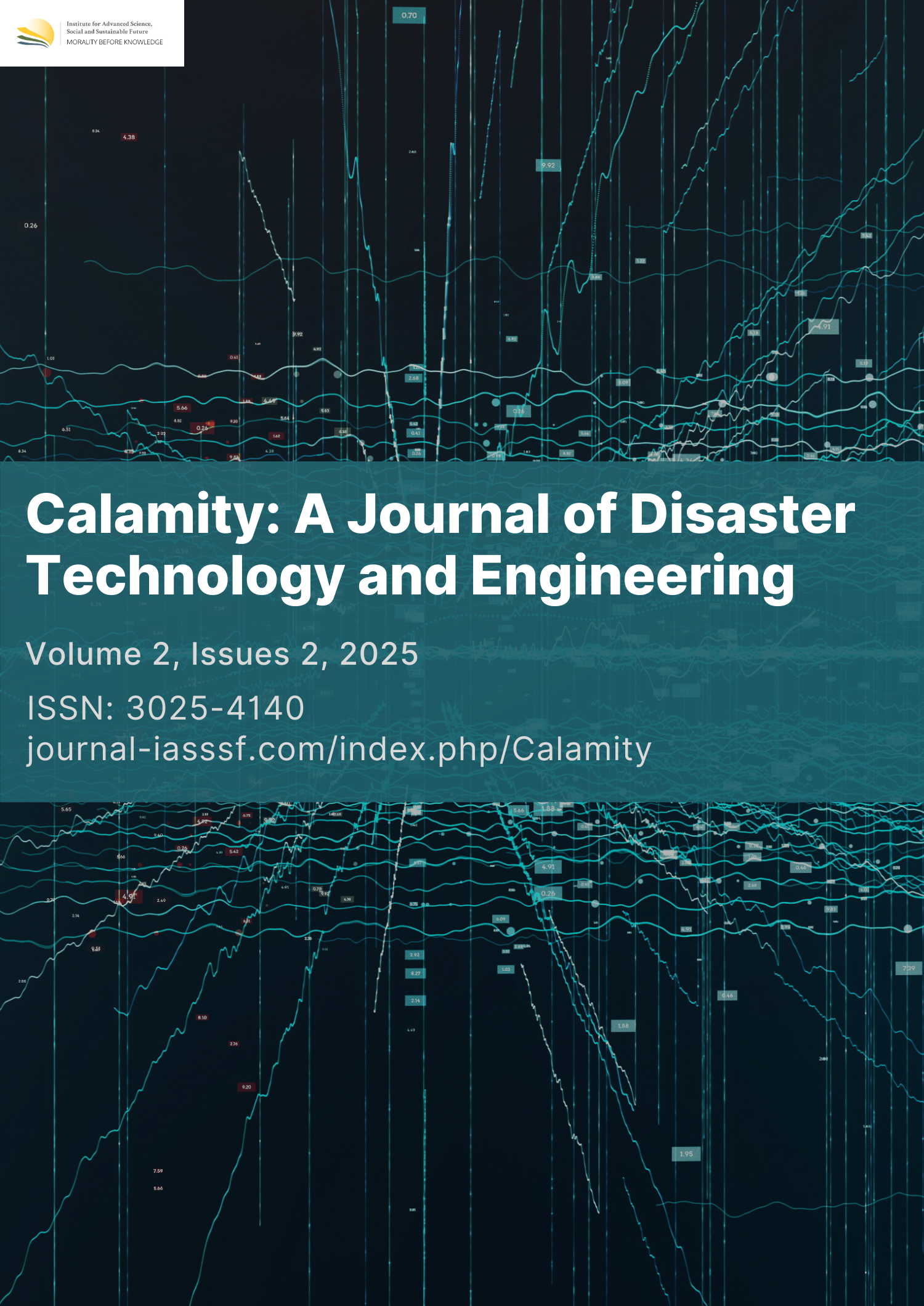Analysis of implementation factors in the application of building information modeling (BIM) in construction projects: Enhancing disaster preparedness
DOI:
https://doi.org/10.61511/calamity.v2i2.2025.1442Keywords:
BIM implementation, Surabaya construction, SmartPLS analysisAbstract
Background: Building Information Modeling (BIM) technology is game-changing in the AEC industry. BIM can significantly improve team coordination, construction productivity, project performance, and profits. The conventional construction process, where there are often conflicts between stakeholders regarding the workflow in a job, will change with the application of BIM in construction projects. In the construction sector in Indonesia, the knowledge and experience of construction service provider companies (consultants and contractors) in Indonesia needs to be studied and documented academically to enrich the body of knowledge of BIM implementation. Methods: The data used in this study are primary data obtained through questionnaires. The data used in this study are quantitative data processed using the Partial Least Square (PLS) method with SmartPLS 4.0 software. Conclusion: From the results of this study, it is concluded that the implementation factor has a significant influence on Building Information Modeling (BIM). Based on the outer model analysis of the SmartPLS 4.0 software, it is found that the greatest influence of the implementation factor relationship on Building Information Modeling (BIM) is 0.757 or it can be said that it is 75.7%. Novelty/Originality of this article: This study provides a unique contribution by focusing on the implementation of Building Information Modeling (BIM) in the Indonesian construction sector, particularly through the lens of construction service providers' knowledge and experience, using a robust quantitative approach with SmartPLS 4.0 to analyze the influence of implementation factors on BIM adoption.
References
Abdirad, H., & Dossick, C. S. (2016). BIM curriculum design in architecture, engineering, and construction education: a systematic review. Journal of Information Technology in Construction (ITcon), 21(17), 250-271. http://www.itcon.org/2016/17
Amarta, K. (2022). Pengaruh Tantangan Kontraktor Di Era Industri 4.0 Terhadap Kesuksesan Perusahaan Konstruksi [Universitas Atma Jaya Jogjakarta]. https://e-journal.uajy.ac.id/27200/
Anasstasia, T. T., & Utami, A. (2022). Manajemen Proyek. UPN “Veteran” Yogyakarta. http://eprints.upnyk.ac.id/id/eprint/34376
Aziz, M. A., Wong, C. F., Haron, N. A., Ales, A. H., Effendi, R. A. A. R. A., & Tan, O. K. (2022). Critical Success Factors For Building Information Modelling (BIM) Implementation For Power Plant Projects in Malaysia. IIUM Engineering Journal, 23(1), 34–45. https://doi.org/10.31436/IIUMEJ.V23I1.2119
Barrung, J. D., & Napitupulu, K. J. H. (2022). Implementasi Building Information Modelling Direktorat Preservasi Jalan Dan Jembatan Wilayah II. Konferensi Regional Teknik Jalan, 12. https://journal.unj.ac.id/unj/index.php/spkts/article/download/35965/15633/
Fadhilah, A., Purwanto, E., & Basuki, A. (2022). Aplikasi Building Information Modelling (BIM) Dalam Perancangan Bangunan Gedung. Matriks Teknik Sipil, 10(3), 264–271. https://doi.org/10.20961/mateksi.v10i3.55999
Febrianti, M. (2022). Studi Critical Success Factors Dalam Peningkatan Kompetensi Tenaga Kerja Konstruksi di Indonesia. Universitas Hasanuddin. https://repository.unhas.ac.id/id/eprint/27314/2/D011181329_skripsi_07-11-2022%201-2.pdf
Gu, N., & London, K. (2010). Understanding and facilitating BIM adoption in the AEC industry. Automation in Construction, 19(8), 988–999. https://doi.org/10.1016/j.autcon.2010.09.002
Hatmoko, J. U. D., & Pandarangga, A. (2021). Konstruksi 4.0: Tantangan dan Inisiatif Penerapan di Indonesia. ANDI.
Hatmoko, J. U. D., Fundra, Y., & Wibowo, M. A. (2019). Investigating building information modelling (BIM) adoption in Indonesia construction industry. In MATEC Web of Conferences (Vol. 258, p. 02006). EDP Sciences. https://doi.org/10.1051/matecconf/201925802006
Khosrowshahi, F., & Arayici, Y. (2012). Roadmap for implementation of BIM in the UK construction industry. Engineering, Construction and Architectural Management, 19(6), 610–635. https://doi.org/10.1108/09699981211277531
Mahapatni, I. A. P. S. (2019). Metode Perencanaan Dan Pengendalian Proyek Konstruksi. UNHI Press.
Mieslenna, C. F., & Wibowo, A. (2019). Mengeksplorasi penerapan Building Information Modeling (BIM) pada industri konstruksi Indonesia dari perspektif pengguna. Jurnal Sosial Ekonomi Pekerjaan Umum, 11(1), 44-58. https://download.garuda.kemdikbud.go.id/article.php?article=1052499&val=14695&title=
Patel, T., Bapat, H., Patel, D., & van der Walt, J. D. (2021). Identification Of Critical Success Factors (CSFs) Of BIM Software Selection: A Combined Approach Of FCM and Fuzzy DEMATEL. Buildings, 11(7). https://doi.org/10.3390/buildings11070311
Pratama, A., & Marzuki, P. F. (2023). Kajian Implementasi BIM (Building Information Modeling) di Indonesia Berdasarkan Perspektif Pelaksana Konstruksi (Studi Kasus: Proyek Kontraktor BUMN). Jurnal Teoretis Dan Terapan Bidang Rekayasa Sipil, 30(2), 277–296. https://doi.org/10.5614/jts.2023.30.2.15
PUPR. (2019). Pedoman Teknis Building Information Modeling (BIM) untuk Bangunan Gedung Negara. Direktorat Jenderal Cipta Karya, Kementerian Pekerjaan Umum dan Perumahan Rakyat. https://binamarga.pu.go.id/uploads/files/1968/12PBM2023-Pedoman-Implementasi-Building-Information-Modelling-BIM-pada-Lingkup-Pekerjaan-Konstruksi-Jalan-dan-Jembatan.pdf
Pusdiklat SDA dan Konstruksi. (2018). Pelatihan Perencanaan Konstruksi Dengan Sistem Teknologi Building Information Modelling (BIM). Kementrian PUPR. https://simantu.pu.go.id/epel/edok/62a75_MODUL_7-STUDI_KASUS_IMPLEMENTASI_BIM_PADA_PROYEK_TERKAIT.pdf
Puspita, N. R., & Patriotika, F. (2021). BIM Implementation in Public Construction Projects in Indonesia. IOP Conference Series: Materials Science and Engineering, 1156(1). https://doi.org/10.1088/1757-899x/1156/1/012008
Putera, I. G. A. A. (2022). Manfaat BIM Dalam Konstruksi Gedung: Suatu Kajian Pustaka. Jurnal Ilmiah Teknik Sipil, 43–52. https://jurnal.harianregional.com/jits/full-89060
Rani, H. A., Al-Mohammad, M. S., Rajabi, M. S., & Rahman, R. A. (2023). Critical Government Strategies for Enhancing Building Information Modeling Implementation in Indonesia. Infrastructures, 8(57). https://doi.org/10.3390/infrastructures8030057
Sari, S. N., & Triwuryanto. (2021). Kajian Pemeliharaan Dan Perawatan Bangunan Gedung Sesuai Dengan Peraturan Menteri Pekerjaan Umum No. 24/PRT/M/2008. Prosiding CEEDRiMS, 347–353. https://publikasiilmiah.ums.ac.id/handle/11617/12728
Succar, B., Sher, W., & Williams, A. (2013). An integrated approach to BIM competency assessment, acquisition and application. Automation in Construction, 35, 174–189. https://doi.org/10.1016/j.autcon.2013.05.016
Tan, S., Gumusburun Ayalp, G., Tel, M. Z., Serter, M., & Metinal, Y. B. (2022). Modeling the Critical Success Factors for BIM Implementation in Developing Countries: Sampling the Turkish AEC Industry. Sustainability (Switzerland), 14. https://doi.org/10.3390/su14159537
Utomo, F. R. (2019). Klasifikasi Faktor-Faktor Penghambat Dan Pendorong Adopsi Building Information Modelling (BIM) Di Indonesia [Institut Teknologi Sepuluh Nopember]. https://repository.its.ac.id/70322/1/09211650026005-Master_Thesis.pdf
Yusuf, G. A. (2018). Critical Success Factors For Building Information Modelling Implementation. Construction Economics and Building, 18(3), 55–73. https://doi.org/10.5130/AJCEB.v18i3.6000
Yusoff, S. N. S., & Brahim, J. (2021). Implementation of building information modeling (Bim) for social heritage buildings in kuala lumpur. International Journal of Sustainable Construction Engineering and Technology, 12(1), 88-99. https://publisher.uthm.edu.my/ojs/index.php/IJSCET/article/view/6353
Zahrizan, Z., Ali, N. M., Marshall-Ponting, A. J., & Abd. Hamid, Z. (2013). Exploring the adoption of Building Information Modelling (BIM) in the Malaysian construction industry: A qualitative approach. International Journal of Research in Engineering and Technology, 2(8), 384–395. https://ijret.org/volumes/2013v02/i08/IJRET20130208060.pdf
Downloads
Published
How to Cite
Issue
Section
Citation Check
License
Copyright (c) 2025 Lathifia Qolbina, Michella Beatrix

This work is licensed under a Creative Commons Attribution 4.0 International License.
















